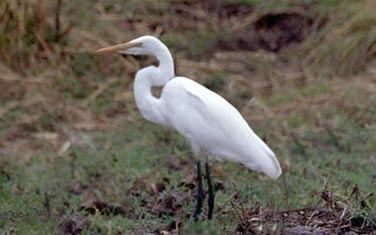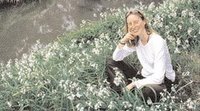- The most touching comment was from Owen O'Brien who was writing to supporting his brother Eris O'Brien, Eris had earlier written in support of my first Blog posting about the madness of wide-spread spraying of Plague Locusts.
- Apparently Eris O'Brien has been roundly criticised for his campaigning against compulsory spraying of farmers' lands - that's right compulsory spraying. He has a website now and a compelling 8 minute video.
- Please take the time to watch it.
The Australian Plague Locust Commission and even the Victorian Premier, "Mr Feral Horse" (John Brumby) is trying to whip us all into a frenzy over this. His best effort was to declare that the Locusts pose a threat to the running of the Melbourne Cup.
Crikey has carried a story about the looming Locust Plague today.
Pretty lame interview, I would say.
Since when is the only measure of "environmental safety" judged by this question: "Are the pesticides used on locusts a problem for humans?"
What about the impact on birds and other native animals? What about the impact on frogs and fish (even if they claim to have "buffer zones" around water courses). What chance there is no spray drift?
Here is the Wikipedia article on the Australian Plague Locust
You’d think the heavy winter rains in Australia’s south-east that broke the drought and filled a struggling river system would have been welcomed by all. But the Big Wet, which looks likely to yield some bumper crops for farmers, may also come at a price. The downpour has been the equivalent of mood lighting and a Barry White record for one of our most feared pests -- Chortoicetes terminifera, the Australian Plague Locust.
The widespread rainfall and warmer temperatures have seen large numbers of locusts begin to hatch across wide areas of regional Australia, leaving more than just farmers nervous about the mischief they might cause. Crikey spoke with Chris Adriaansen, director of the Australian Plague Locust Commission, about how a few billion scary grasshoppers might ruin it for everyone.
Why are there going to be more locusts this year than in the past?
It’s a seasonal thing that is a combination of rainfall, aggregation and how each generation multiplies. Australian plague locusts have four generations each season and each generation can multiply on the previous if conditions are good. It’s an unfortunate coincidence of nature that the same conditions that gave rise to a good crop and grassing situation have led to this locust plague. Primarily it’s all about widespread rainfall and good temperatures.
When are the locusts expected to hatch?
There have already been some hatchings and we have seen some significant locust populations in the north-west of NSW. Those locusts hatched 7-10 days ago and have aggregated in large numbers (full predicted locust hatching dates can be found here).
How many locusts are we talking?
How many grains of sand are there on a beach? We are talking literally billions of locusts. Anything up to 5 million hectares of land will be infected by locust eggs, so do the maths if you have a calculator with enough zeroes.
How many locusts are there in a swarm?
According to the APLC, a swarm of Australian plague locusts, covering one square kilometre, could contain anything from 4 million to over 50 million locusts. The size of a typical Australian plague locust swarm is highly variable, from one to over 25 kilometres squared
Which areas are at greatest risk from a locust plague?
We’ve got a number of key risk zones. The central-west region of NSW, the Riverina region of NSW, the north, in particular north-west, of Victoria, and the eastern Flinders region of South Australia.
How long will it take before the locusts begin to cause problems?
Locusts have five stages of development as nymphs when they have no wings, so we won’t see any swarms of locusts for at least another six weeks. The majority of the high density areas in places like Victoria are yet to hatch, so it will be at least eight weeks until we begin to see swarms in those areas. But the swarms are only part of the risk. The nymph’s sole purpose is eating and growing, so they can still do quite an amount of damage.
How far and how quickly can they move?
When they’re at the nymph stage they don’t move very far at all, because they don’t have wings they can move around 200-250m per day. Once they grow wings it’s a different story, they can move around 20-40km per day. Overnight they can fly up to 700km, as long as they get the right wind conditions. So basically they can be here today and gone tomorrow. But I don’t think we will be seeing that this time, there is just too many of them.
Which industries are at greatest risk from a locust plague?
The normal diet of these species is grass and the associated plants. Probably the most significant risk is to grain crops, so wheat and barley and other crops such as canola and the pastures areas where livestock grows.
What kind of damage can they do to crops?
They can completely wipe out a crop. If they don’t take 100% of the vegetation, they can destroy large amounts of plant material so that a crop’s yield is significantly reduced.
Is there a chance they could move from farms into some of the larger regional towns, and even cities?
We do see that from time to time. Certainly the swarm of locusts in April did move into some larger regional centres. In the Mildura area during April we saw a number of community events halted, including sporting events. The local airport was also closed and Virgin Blue halted their flights into Mildura because of the problems posed by the locusts.
What kind of damage can they do to cars?
One is obviously visibility; these locusts are going to be well fed and fat, so when they hit the windscreen the fat will be smeared everywhere. The other issue is the blocking of air intakes, which can lead to an engine overheating.
Who is in charge of the response to the locusts?
It’s a collaborative arrangement. APLC has a role and responsibility; our stated mandate is to monitor and manage locust populations that are found in more than one state. But each of the state’s agencies has a key role to play. What we have done since April is bring everyone together and plan a response so we can have this covered as best we can.
How are you managing the locusts?
There are range of different control agents that can be used to manage the locusts, whether from the ground or air. Landholders and ground control contractors undertake ground-based spraying, while the state controlled agencies and APLC undertake aerial spraying.
Are the pesticides used on locusts a problem for humans?
First of all of these pesticides are registered with the Australian Pesticides and Veterinary Medicines Authority. Secondly, we leave a very significant buffer zone around human activity, water courses and restricted or significant areas. Thirdly, we have developed a number of techniques in that we don’t blanket spray areas, we leave 90% of land area untreated and then leave it up to locusts to discover the discreet chemical strips we lay down.
This is not a pest eradication program; locusts are a native insect and we are trying to manage the issue as best we can.
End of the Crikey Article.
That's right. These chemicals may be sprayed on cereal crops (which you or your meat animals are meant to eat). But the intention is to poison the Locusts which try to eat the cereal crops.
Sure there is such a thing as a "withholding period" That is meant to be a time after which the poison has broken down sufficiently to be "safe".
But do you really want your food, or the food your own food animals eat to be sprayed with this list of chemicals?
Table 2 from the newly revised Plague Locust Control Fact Sheet (page 3) authorises the use of these chemicals on cereal crops.
Table 2 CEREALS
APVMA permits – users must obtain, read and adhere to the conditions of APVMA permits prior to use.
Approvals for all cereals (Including but not limited to wheat, barley, durum, oats, cereal rye, maize, sorghum & triticale)
carbaryl Registered Registered # 1 day 1 day
chlorpyrifos Registered 10 days 2 days
diazinon 14 days 14 days
cypermethrin PER10928 # 21 days 35 days
alpha-cypermethrin PER10927 # 7 days 14 days
beta-cyfluthrin # 14 days 7 days
fenitrothion Registered 14 days 14 days
maldison Registered Registered 1 day 1 day
metarhizium anisopliae Registered not specified not specified
methidathion PER11658 * 42 days 7 days
Approvals for individual cereal crops
Wheat & Barley
gamma-cyhalothrin PER10927 # 14 days 14 days
lambda-cyhalothrin # 14 days 14 days
Maize
alpha-cypermethrin PER10927 # 7 days not specified
cypermethrin PER10928 # 7 days not specified
Sorghum
diazinon Registered 14 days 14 days
fipronil 14 days 14 days
alpha-cypermethrin PER10927 # 7 days not specified
beta-cyfluthrin # 14 days 14 days
chlorpyrifos Registered # 2 days 2 days
cypermethrin PER10928 # 14 days 49 days
gamma-cyhalothrin PER10927 # 14 days 14 days
lambda-cyhalothrin # 14 days 14 days
WHP (withholding period) - Following pesticide application, the relevant withholding period MUST expire BEFORE cutting for hay, windrowing, harvest or the undertaking of any similar operation.
- # Permit not required as Victorian ‘control-of-use’ legislation allows this off-label use in Victoria. For further information contact DPI Victoria.
- ^ The Safemeat Plague Locust Brochure should be consulted for information on managing residues in livestock – www.safemeat.com.au
- * Methidathion, an S7 chemical, cannot be used off-label in Victoria unless an S25A permit has been issued by DPI Victoria.
"Schedule 7s are substances with a high potential for causing harm at low exposure and which require special precautions in manufacture handling or use. These poisons should be available only to specialised or authorised officers who have the skills necessary to handle them safely."
Did you get that?
These chemicals have to be "handled safely" (by specially trained and authorised personnel), but they can be sprayed on cereal crops which you or your food animals will eat. Just as soon as the "withholding period" has expired.
Please enjoy your next meal, as Mr Brumby thinks that it is reasonable for these chemicals to be used on your food, to ensure the Melbourne Cup goes ahead .















